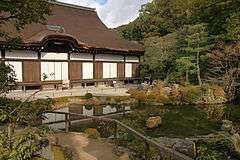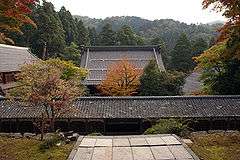Buddhism in Japan
Buddhism in Japan has been practiced since its official introduction in 552 CE according to the Nihon Shoki[2] from Baekje, Korea, by Buddhist monks.[3][4] Buddhism has had a major influence on the development of Japanese society and remains an influential aspect of the culture to this day.[5]
_(42096289494).jpg) The Great Buddha (Daibutsu) at Kōtoku-in, Kamakura, in Kanagawa Prefecture, Japan (National Treasure) | |
| Total population | |
|---|---|
| c. 84 million or 67% (Government est., 2018)[1] | |
| Regions with significant populations | |
| Throughout Japan | |
| Religions | |
| Languages | |
| Japanese and other languages |
| Part of a series on |
| Buddhism in Japan |
|---|
 |
|
Sacred texts
|
According to the Japanese Government's Agency for Cultural Affairs estimate, as of the end of 2018, with about 84 million or about 67% of the Japanese population, Buddhism was the religion in Japan with the second most adherents, next to Shintoism, though a large number of people practice elements of both.[1] There are a wide range of estimates though. The Pew Research Center estimated 36.2% of the population in 2010 practiced Buddhism.[6] The Japanese General Social Survey places the figure at less than 20% of the population in 2017, and along with the 2013 Japanese National Character Survey, shows that roughly 70% of the population do not adhere to any religious beliefs.[7]
In modern times, Japan's popular schools of Buddhism are Pure Land Buddhism, Nichiren Buddhism, Shingon Buddhism and Zen. About 60% of the Japanese have a Butsudan (Buddhist shrine) in their homes.[8]
History of Japanese Buddhism
Arrival of Buddhism in China along the Silk Road
The arrival of Buddhism in China is ultimately a consequence of the first contacts between China and Central Asia, where Buddhism had spread from the Indian subcontinent. These contacts occurred with the opening of the Silk Road in the 2nd century BCE, following the travels of Zhang Qian between 138 and 126 BCE. These contacts culminated with the official introduction of Buddhism in China in 67 CE. Historians generally agree that by the middle of the 1st century, the religion had penetrated to areas north of the Huai River in China.[9]
Kofun period (250 to 538)
According to the Book of Liang, which was written in 635, five Buddhist monks from Gandhara traveled to Japan in 467. At the time, they referred to Japan as Fusang (Chinese: 扶桑; Japanese pronunciation: Fusō), the name of a mythological country to the extreme east beyond the sea:[10]
Fusang is located to the east of China, 20,000 li (1,500 kilometers) east of the state of Da Han [大漢, "China"] (itself east of the state of Wa in modern Kansai region, Japan). (...) In former times, the people of Fusang knew nothing of the Buddhist religion, but in the second year of Da Ming of the Song Dynasty (467), five monks from Kipin [Kabul region of Gandhara] travelled by ship to Fusang. They propagated Buddhist doctrine, circulated scriptures and drawings, and advised the people to relinquish worldly attachments. As a result the customs of Fusang changed.
— the monk Hui Shen (慧深), Book of Liang, 7th century[lower-alpha 1]
Asuka Period (538 to 710) and Nara Period (710–794)
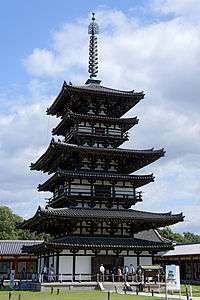
Although there are records of Buddhist monks from China coming to Japan before the Asuka Period, the "official" introduction of Buddhism to Japan is dated to 552 in Nihon Shoki[11] when King Seong of Baekje (聖明王, now western Korea) sent a mission to the Emperor Kinmei that included Buddhist monks or nuns together with an image of Buddha and a number of sutras to introduce Buddhism.[4][12] The powerful Soga clan played a key role in the early spread of Buddhism in the country. Initial uptake of the new faith was slow, and Buddhism only started to spread some years later when Empress Suiko openly encouraged the acceptance of Buddhism among all Japanese people.
According to legend, in 552, there was an attempt to destroy a tooth relic, one of the first of Buddha's to arrive in the country; it was hit by a hammer into an anvil. The hammer and anvil were destroyed but the tooth was not.[13] On January 15, 593, Soga no Umako ordered relics of Buddha deposited inside the foundation stone under the pillar of a pagoda at Asuka-dera.[14]
In 607, in order to obtain copies of sutras, an imperial envoy was dispatched to Sui China. As time progressed and the number of Buddhist clergy increased, the offices of Sōjō (archbishop) and Sōzu (bishop) were created. By 627, there were 46 Buddhist temples, 816 Buddhist priests, and 569 Buddhist nuns in Japan.
Six sects
The initial period saw the six great Chinese schools, called Nanto Rokushū (南都六宗, lit. the Six Nara Sects) in Japanese were introduced to the Japanese archipelago:
- Ritsu (Vinaya-focused Nikaya Buddhism)
- Jōjitsu (Tattvasiddhi, a sect of Nikaya Buddhism)
- Kusha-shū (Abhidharma-focused Nikaya Buddhism)
- Sanronshū (East Asian Mādhyamaka)
- Hossō (East Asian Yogācāra)
- Kegon (Huayan)[15]
These schools were centered around the ancient capitals of Asuka and Nara, where great temples such as the Asuka-dera and Tōdai-ji were erected respectively. These were not exclusive schools, and temples were apt to have scholars versed in several of the schools. It has been suggested that they can best be thought of as "study groups". The Buddhism of these periods, known as the Asuka period and Nara period – was not a practical religion, being more the domain of learned priests whose official function was to pray for the peace and prosperity of the state and imperial house. This kind of Buddhism had little to offer to the illiterate and uneducated masses and led to the growth of "people’s priests" who were not ordained and had no formal Buddhist training. Their practice was a combination of Buddhist and Daoist elements and the incorporation of shamanistic features of indigenous practices. Some of these figures became immensely popular and were a source of criticism towards the sophisticated academic and bureaucratic Buddhism of the capital.
Tangmi
The Late Nara period saw the introduction of Tangmi (Esoteric Buddhism, Japanese mikkyō) to Japan from China by Kūkai and Saichō, who founded Shingon Buddhism and the Tendai school, respectively.
Heian Period (794 to 1185)
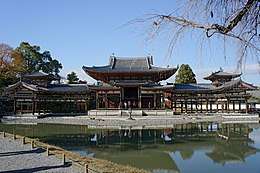
During the Heian period the capital was shifted from Nara to Kyoto. Monasteries became centers of powers, even establishing armies of Sōhei, warrior-monks.[16]
Shinto and Buddhism became the dominant religions, maintaining a balance until the Meiji-restoration.[16]
Kamakura Period (1185–1333)
The Kamakura period was a period of crisis in which the control of the country moved from the imperial aristocracy to the samurai. In 1185 the Kamakura shogunate was established at Kamakura.[17]
This period saw the introduction of the two schools that had perhaps the greatest impact on the country: the schools of Pure Land Buddhism, promulgated by evangelists such as Genshin and articulated by monks such as Hōnen, which emphasize salvation through faith in Amitābha and remain the largest Buddhist sect in Japan (and throughout Asia); and Zen, promulgated by monks such as Eisai and Dōgen, which emphasize liberation through the insight of meditation, which were equally rapidly adopted by the upper classes and had a profound impact on the culture of Japan.
Additionally, it was during the Kamakura period that the influential monk Nichiren began teaching devotion to the Lotus Sutra. Eventually, his disciples formed their own school of Nichiren Buddhism, which includes various sects that have their own interpretations of Nichiren's teachings. Nichiren Buddhism established the foundation of Japanese Buddhism in the thirteenth century. The school is known for its sociopolitical activism and looks to reform society through faith.[18]
Muromachi Period (or Ashikaga) (1336–1573)
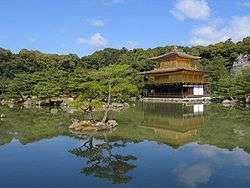
In the Muromachi period, Zen, particularly the Rinzai school, obtained the help of the Ashikaga shogunate and the Emperor of Japan, and accomplished considerable development.
Azuchi-Momoyama Period (1573–1600) and Edo Period (or Tokugawa) (1600–1868)
After the Sengoku period of war, Japan was re-united in the Azuchi–Momoyama period. This decreased the power of Buddhism, which had become a strong political and military force in Japan. Neo-Confucianism and Shinto gained influence at the expense of Buddhism, which came under strict state control.[19] Japan closed itself off to the rest of the world. The only traders to be allowed were Dutchmen admitted to the island of Dejima.[20]
New doctrines and methods were not to be introduced, nor were new temples and schools. The only exception was the Ōbaku lineage, which was introduced in the 17th century during the Edo period by Ingen, a Chinese monk. Ingen had been a member of the Linji school, the Chinese equivalent of Rinzai, which had developed separately from the Japanese branch for hundreds of years. Thus, when Ingen journeyed to Japan following the fall of the Ming dynasty to the Manchu people, his teachings were seen as a separate school. The Ōbaku school was named after Mount Huangbo (Chinese: 黄檗山; pinyin: Huángbò shān; Japanese pronunciation: Ōbaku san), which had been Ingen's home in China. Also notable during the period was the publication of an exceptionally high quality reprint of the Ming-era Tripiṭaka by Tetsugen Doko, a renowned master of the Ōbaku school.[19]
Meiji Restoration (1868–1912)
With the Meiji Restoration in 1868, the new government adopted a strong anti-Buddhist attitude, and a movement to eradicate Buddhism and bring Shinto to ascendancy arose throughout the country due to the strong connections of Buddhism to the Shōguns.
During the Meiji period (1868–1912), after a coup in 1868, Japan abandoned its feudal system and opened up to Western modernism. Shinto became the state religion. Within the Buddhist establishment the Western world was seen as a threat as well as a challenge to stand up to.[21][22] Buddhist institutions had a simple choice: adapt or perish. Rinzai and Soto Zen chose to adapt, trying to modernize Zen in accord with Western insights, while simultaneously maintaining a Japanese identity. Other schools, and Buddhism in general, simply saw their influence wane. The edict of April 1872 ended the status of the Buddhist precepts as state law and allowed monks to marry and to eat meat.[23] This "codification of a secularized lifestyle for the monk coupled with the revival of the emperor system and development of State Shinto were fundamental in desacralizing Buddhism and pushing it to the margins of society".[24]
Japanese Imperialism (1931–1945)
Japanese identity was being articulated in Nihonjinron, the "Japanese uniqueness theory". A broad range of subjects was taken as typical of Japanese culture. D. T. Suzuki contributed to the Nihonjinron by taking Zen as the distinctive token of Asian spirituality, showing its unique character in the Japanese culture.[25] Nichirenism was one particular expression of Japanese Buddhist nationalism.
During World War II, almost all Buddhists institutions strongly supported Japan's militarization.[26][27][28][29][30][31][32] In contrast, a few individuals such as Ichikawa Hakugen,[33] and Girō Seno’o were targeted, and the Soka Kyoiku Gakkai, a Nichiren lay believers' organization, was ultimately banned by military authorities. During the 1940s, "leaders of both Honmon Hokkeshu and Sokka Gakkai were imprisoned for their defiance of wartime government religious policy, which mandated display of reverence for state Shinto."[34][35][36]
Post World War II, there was a high demand for Buddhist priests who glorified fallen soldiers, and gave funerals and posthumous names, causing a strong revival.[37] However, due to secularization and the growth of materialism, Buddhism and religion in general continued to decline.
Post-war (1945–present)
Japan has seen a growth in post war movements of lay believers of Buddhism and a decline in traditional Buddhism in the 20th century, with roughly 100 Buddhist organizations disappearing every year.[38][39] As of 2008 approximately 34% of the Japanese identify as "Buddhists" and the number has been growing since the 1980s, as Buddhists were 27% in 1984.
Still, around 90% of Japanese funerals are conducted according to Buddhist rites.[40] "In 1963, Tamamoro Taijo coined the term Funeral Buddhism that came to be used to describe traditional Buddhism in Japan as the religion engaged in funerary rites and removed from the spiritual needs of people."[41]
Contrary to the ritualistic practice of traditional Buddhism, a revived modern form of Nichiren Buddhism led by lay believers Soka Gakkai "... grew rapidly in the chaos of post war Japan[36] from about 3000 members in 1951 to over 8 million members" in 2000,[42] and has established schools, colleges and a university, as well as cultural institutions.[43] A study about the reason for the growth in lay believers and increased engagement in society attributes the cause to Nichiren teachings of 'social responsibility': "In the tradition of Nichiren Buddhism, however, we find the Lotus Sutra linked to a view of social responsibility that is distinctive".[44] According to an academic study, lay believers of Buddhism "...{nbsp}offer an alternative view of Japan where their form of Buddhism would form the religious foundation of a peaceful and psychologically and materially enriched society".[45]
Japanese Buddhist schools
- "East Asian Buddhism is very diverse in its teachings and monastic practices, and Japanese Buddhism, in particular, represents almost every strand of Buddhist teachings and practices. However, in comparison to Chinese or Korean Buddhist schools that are generally more united and less sectarian in their groupings, Buddhist denominations in Japan have developed into independent sects with autonomous organizations that have differing emphases on the doctrine and separate lay followings." (Authors: Kawananami, Partridge, and Woodhead p. 82.)
In the post-Meiji, pre-WWII period, there were officially 13 schools and 56 branches of traditional Buddhism (i.e., those not established in modern times). The official schools included three from the Nara period, two from the Heian period (Tendai and Shingon), four Pure Land schools, three Zen schools (Rinzai, Sōtō and Ōbaku), and Nichiren. During the war, this was halved to 28 branches, but the law enforcing this was repealed following the end of the war, allowing former branches to return. Further, since then, many groups have split off from existing branches.
The Six Nara Schools
Jōjitsu
625: Introduced into Japan. The Tattvasiddhi school (成實宗, Jōjitsu-shū)[46] (formerly known as the *Sātyasiddhi) is considered to be an offshoot of the Bahuśrutīya, an Indian Sautrāntika school of Nikaya Buddhism; however, the Tattva Siddhi's position was also close to that of the Sthavira nikāya. They were distinguished by a rejection of abhidharma as not being the words of the Buddha. It was introduced to Japan as Jōjitsu in 625 by the monk Ekwan of Goryeo. In Japan, it was classified as one of the three approaches of East Asian Mādhyamaka instead of a separate lineage.[47] East Asian Mādhyamaka (三論宗, Sanron-shū) was one of the six Nara sects (南都六宗, Nanto Rokushū).[46]
Hossō
654: Dōshō introduces East Asian Yogācāra (法相宗, Hossō). Yogācāra is based on an early Indian philosophy by masters such as Vasubandhu. Practices of this lineage are also known as "consciousness-only" since they teach that all phenomena are phenomena of the mind. The East Asian Yogācāra school of Buddhism was founded by Xuanzang (玄奘, Jp. Genjō) in China c. 630 and introduced to Japan in 654 by Dōshō, who had travelled to China to study under him.[48] The Discourse on the Theory of Consciousness-Only (成唯識論, Jōyuishiki-ron) is an important text for the Hossō school.
Sanron
This school was transmitted to Japan in the 7th century. Literally: Three-Discourse School; a Madhyamaka school which developed in China based on two discourses by Nagarjuna and one by Aryadeva. Madhyamaka is one of the two most important Mahayana philosophies, and reemphasizes the original Buddhist teachings that phenomena are neither truly existent or absolutely non-existent, but are characterized by impermanence and insubstantiality.
Kegon
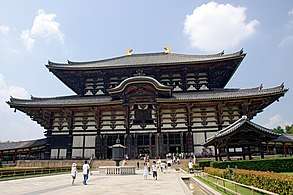
736: Bodhisena introduces the Kegon (Huayan or Avataṃsaka) school to Japan. The Kegon school was founded by Dushun (杜順, Dojun) c. 600 and was introduced to Japan by the Indian monk Bodhisena in 736. The Avatamsaka Sutra (Kegon-kyō 華厳経) is the central text for the Kegon school. The Shin'yaku Kegonkyō Ongi Shiki is an early Japanese annotation of this sūtra.
Risshū
753: Jianzhen (Chinese: 鑑真) introduces the Risshū (Ritsu or vinaya school) to Japan.
Founded by Daoxuan (道宣, Jp. Dosen), China, c. 650
First Introduction to Japan: Jianzhen, 753. The Ritsu school specialized in the Vinaya (the monastic rules in the Tripitaka). They used the Dharmagupta version of the vinaya which is known in Japanese as Shibunritsu (四分律)
Kusha-shū
The Kusha-shū (倶舎宗) was one of the six schools of Buddhism introduced to Japan during the Asuka and Nara periods.[49] Along with the Tattvasiddhi school (Jōjitsu-shū) and the Risshū, it is a school of Nikaya Buddhism, which is sometimes derisively known to Mahayana Buddhism as "the Hinayana".
A Sarvastivada school,[50] Kusha-shū focussed on abhidharma analysis based on the "Commentary on the Abhidharmakośabhaṣya" (倶舎論) by the fourth-century Gandharan philosopher Vasubandhu. The school takes its name from that authoritative text.[49]
Esoteric Schools
Tendai
807: Saichō introduces the Tendai (Tiantai) school to Japan. Known as Tiantai (天台) in China, the Tendai school was founded by Zhiyi (智顗, Jp Chigi) in China, c. 550. In 804 Saichō (最澄) traveled to China to study at the Tiantai teachings, at Mount Tiantai. However, before his return he also studied, and was initiated into, the practice of the Vajrayana, with emphasis on the Mahavairocana Sutra. The primary text of Tiantai is Lotus Sutra (Hokke-kyō 法華経), but when Saichō established his school in Japan he incorporated the study and practice of Vajrayana as well. Although the studies of the Lotus Sutra and Mahayana Nirvana Sutra were also very vital to the schools as well. These schools developed in the Middle Ages and were influenced by the Tientai, Chinese schools of the sixth century. [51]
Shingon Buddhism
816: Kūkai founds Shingon Buddhism (真言宗, Shingon-shū). One of the major schools of Buddhism in Japan today and one of the few surviving Vajrayana lineages in East Asia, it originally spread from India to China through traveling monks such as Vajrabodhi and Amoghavajra. Known in Chinese as the Tangmi, these esoteric teachings would flourish in Japan under the auspices of a Buddhist monk named Kūkai (空海), who traveled to Tang China in 804 as part of the same expedition as Saichō. In the capital he studied Tangmi and Sanskrit and received initiation from Huiguo. On returning to Japan, Kūkai eventually managed to establish Shingon as a school in its own right. Kūkai received two lineages of teaching—one based on the Mahavairocana Tantra (大日経, Dainichikyō) and the other based on the Vajrasekhara Sutra (金剛頂経, Kongōchōkyō).
The word "Shingon" is the Japanese pronunciation of Zhēnyán "True Words",[52] which in turn is the Chinese translation of the Sanskrit word "mantra".[53]
Kamakura Buddhism
Amida (Pure Land) Schools
1175: Hōnen introduces Pure Land Buddhism to Japan.
Jōdo-shū
Jōdo-shū was founded by Hōnen (法然), 1175
Japanese name: 浄土, "Pure Land"
Major Influences: Chinese Jingtu Zong (净土宗 "Pure Land school"), Tendai
Doctrine: Nianfo
Primary Text: Longer Sukhāvatīvyūha Sūtra (Muryōju-kyō 無量壽経)
Jōdo Shinshū
Jōdo Shinshū was founded by Shinran (親鸞), 1224
Japanese name: 浄土真, "True Pure Land"
Major Influences: Jōdo-shū, Tendai
Doctrine: nembutsu no shinjin ("nianfo of true entrusting", that is, saying nianfo is a declaration of faith in Amida's salvation plan for the individual rather than a plan for salvation.)
Primary Text: Longer Sukhāvatīvyūha Sūtra (Muryōju-kyō 無量壽経)
Ji-shū
Ji-shū was founded by Ippen (一遍), 1270
Japanese name: 時宗 or 時衆, "Time"
Major Influences: Jōdo-shū
Doctrine: Nembutsu
Primary Text:
Yūzū-Nembutsu School
The Yūzū-Nembutsu school was founded by Ryōnin (良忍), 1117
Japanese name: 融通念仏
Doctrine: sokushitsu ōjō (速疾往生,)
Primary Text: Avatamsaka Sutra (Kegon-kyō 華厳経)・Lotus Sutra (Hokke-kyō 法華経)
Zen Schools
Several variants of Zen's practice and experiential wisdom (禅宗) were separately brought to Japan. Note that Zen influences are identifiable earlier in Japanese Buddhism, esp. cross-fertilization with Hosso and Kegon, but the independent schools were formed quite late.
Rinzai
1191: Eisai introduces the Rinzai school to Japan.
Founder: Linji Yixuan (臨済義玄), China, c. 850
Chinese name: Linji school (臨済宗), named after founder
First Introduction to Japan: Eisai (栄西), 1191
Major Influences: East Asian Yogācāra, Kegon
Doctrine: zazen (坐禅, "sitting meditation"), especially kōan (公案, "public matter") practice
Primary Texts: Transcendental Wisdom Sutras aka Prajnaparamita (般若波羅蜜経), incl. Heart Sutra
Sōtō
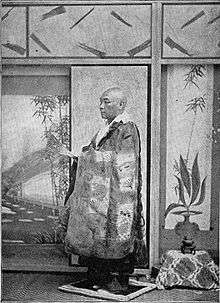
1227: Dōgen introduces the Sōtō (Caodong school) to Japan.
Founders: Caoshan (曹山, Jp. Sosan) and Dongshan Liangjie (洞山, Jp. Tosan), China, c. 850
Chinese name: Caodong (曹洞), named after its founders
First Introduction to Japan: Dōgen (道元), 1227
Major Influences: Tendai, East Asian Yogācāra, Kegon
Doctrine: zazen (坐禅, "sitting meditation"), especially shikantaza
Primary Texts: Transcendental Wisdom Sutras aka Prajnaparamita (般若波羅蜜経), incl. Heart Sutra
Ōbaku School
1654: Ingen introduces the Ōbaku (Huangbo) school to Japan.
Founder: Ingen (隠元), Japan, 1654
Japanese name: Huangbo (黄檗), named for the mountain where the founder had lived in China
Major Influences: Rinzai school
Doctrine: kyōzen-itchi (経禅一致, "Unity of Sutras and Zen")
Primary Texts: Transcendental Wisdom Sutras aka Prajnaparamita (般若波羅蜜経), incl. Heart Sutra
Fuke-shū
The Fuke-shū was founded by Puhua (普化)
First introduction to Japan: Shinchi Kakushin (心地覚心), 1254
Major Influences: Rinzai school
Abolished: 1871
Nichiren Buddhism
1253: Nichiren (日蓮: "Sun-Lotus") expounds his teachings.
Nichiren Buddhism split into several denominations after the death of Nichiren in 1282. The Nichiren Fuju-fuse-ha sub-sect of Nichiren Buddhism was abolished in 1669 and legalised again in 1876.
Today's Nichiren Buddhism is represented by traditional-oriented schools such as Honmon Butsuryū-shū, Nichiren-shū and Nichiren Shōshū and more recent movements like the Soka Gakkai, Risshō Kōsei Kai, Reiyūkai and Nipponzan-Myōhōji-Daisanga. See Nichiren Buddhism for a more complete list.
Major Influences: Tendai
Primary Texts: Lotus Sutra (妙法蓮華經: Myōhō Renge Kyō; abbrev. 法華經: Hokke-kyō), treatises and letters by Nichiren.
Mantra: Nam(u) Myōhō Renge Kyō (南無妙法蓮華經)
Cultural influence
Societal influence
During the Kamakura (1185–1333) and Muromachi (1336–1573) Buddhism, or the Buddhist institutions, had a great influence on Japanese society. Buddhist institutions were used by the shogunate to control the country. During the Edo (1600–1868) this power was constricted, to be followed by persecutions at the beginning of the Meiji restoration (1868–1912).[20] Buddhist temples played a major administrative role during the Edo period, through the Danka or terauke system. In this, Japanese citizens were required to register at their local Buddhist temples and obtain a certification (terauke), which became necessary to function in society. At first, this system was put into place to suppress Christianity, but over time it took on the larger role of census and population control.
Artistic influence
Left: Greek wind god from Hadda, Afghanistan, second century.
Middle: wind god from Kizil Caves, Tarim Basin, 7th century.
Right: Japanese wind god Fūjin, 17th century.
In Japan, Buddhist art started to develop as the country converted to Buddhism in 548. Some tiles from the Asuka period (shown above), the first period following the conversion of the country to Buddhism, display a strikingly classical style, with ample Hellenistic dress and realistically rendered body shape characteristic of Greco-Buddhist art.
Buddhist art became extremely varied in its expression. Many elements of Greco-Buddhist art remain to this day however, such as the Hercules inspiration behind the Nio guardian deities in front of Japanese Buddhist temples, or representations of the Buddha reminiscent of Greek art such as the Buddha in Kamakura.[lower-alpha 2]
Deities
1) Heracles (Louvre Museum).
2) Heracles on coin of Greco-Bactrian king Demetrius I.
3) Vajrapani, the protector of the Buddha, depicted as Heracles in the Greco-Buddhist art of Gandhara.
4) Shukongōshin, manifestation of Vajrapani, as protector deity of Buddhist temples in Japan.
Various other Greco-Buddhist artistic influences can be found in the Japanese Buddhist pantheon, the most striking being that of the Japanese wind god Fūjin. In consistency with Greek iconography for the wind god Boreas, the Japanese wind god holds above his head with his two hands a draping or "wind bag" in the same general attitude.[lower-alpha 3] The abundance of hair has been kept in the Japanese rendering, as well as exaggerated facial features.
Another Buddhist deity, Shukongōshin, one of the wrath-filled protector deities of Buddhist temples in Japan, is also an interesting case of transmission of the image of the famous Greek god Heracles to East Asia along the Silk Road. Heracles was used in Greco-Buddhist art to represent Vajrapani, the protector of the Buddha, and his representation was then used in China and Japan to depict the protector gods of Buddhist temples.[lower-alpha 4]
Artistic motifs
The artistic inspiration from Greek floral scrolls is found quite literally in the decoration of Japanese roof tiles, one of the only remaining element of wooden architecture throughout centuries. The clearest ones are from the 7th century Nara temple building tiles, some of them exactly depicting vines and grapes. These motifs have evolved towards more symbolic representations, but essentially remain to this day in many Japanese traditional buildings.[lower-alpha 5]
Architecture and Temples
Soga no Umako built Hōkō-ji, the first temple in Japan, between 588 to 596. It was later renamed as Asuka-dera for Asuka, the name of the capital where it was located. Unlike early Shinto shrines, early Buddhist temples were highly ornamental and strictly symmetrical. The early Heian period (9th–10th century) saw an evolution of style based on the mikkyō sects Tendai and Shingon Buddhism. The Daibutsuyō style and the Zenshūyō style emerged in the late 12th or early 13th century.
Buddhist holidays
Obon (お盆)
Although its date and practices vary region to region, the Bon Festival is celebrated primarily in Japan and in communities with large Japanese diaspora communities. It is believed that the spirits of the dead return to earth for three days and visit the family shrines or graves. It is customary to clean the graves and to hold family reunions.
See also
Notes
- In the original Chinese: "扶桑在大漢國東二萬餘里,地在中國之東(...)其俗舊無佛法,宋大明二年,罽賓國嘗有比丘五人游行至其國,流通佛法,經像,教令出家,風 俗遂改"
- Katsumi Tanabe: "Needless to say, the influence of Greek art on Japanese Buddhist art, via the Buddhist art of Gandhara and India, was already partly known in, for example, the comparison of the wavy drapery of the Buddha images, in what was, originally, a typical Greek style" (Katsumi Tanabe, "Alexander the Great, East-West cultural contacts from Greece to Japan", p. 19)
- >Katusmi Tanabe: "The Japanese wind god images do not belong to a separate tradition apart from that of their Western counter-parts but share the same origins. (...) One of the characteristics of these Far Eastern wind god images is the wind bag held by this god with both hands, the origin of which can be traced back to the shawl or mantle worn by Boreas/ Oado." (Katsumi Tanabe, "Alexander the Great, East-West cultural contacts from Greece to Japan", p. 21)
- Katsumi Tanabe: "The origin of the image of Vajrapani should be explained. This deity is the protector and guide of the Buddha Sakyamuni. His image was modelled after that of Hercules. (...) The Gandharan Vajrapani was transformed in Central Asia and China and afterwards transmitted to Japan, where it exerted stylistic influences on the wrestler-like statues of the Guardian Deities (Nio)." (Katsumi Tanabe, "Alexander the Great, East-West cultural contacts from Greece to Japan", p. 23)
- The transmission of the floral scroll pattern from West to East is presented in the regular exhibition of Ancient Japanese Art, at the Tokyo National Museum.
References
- 宗教年鑑 令和元年版 [Religious Yearbook 2019] (PDF) (in Japanese). Agency for Cultural Affairs, Government of Japan. 2019. p. 35.
- Bowring, Richard John (2005). The religious traditions of Japan, 500–1600. Cambridge, UK: Cambridge University Press. pp. 16–17. ISBN 0-521-85119-X.
- Bowring, Richard John (2005). The religious traditions of Japan, 500–1600. Cambridge, UK: Cambridge University Press. pp. 15–17. ISBN 0-521-85119-X.
- Dykstra, Yoshiko Kurata; De Bary, William Theodore (2001). Sources of Japanese tradition. New York: Columbia University Press. pp. 100. ISBN 0-231-12138-5.
- Asia Society Buddhism in Japan, accessed July 2012
- "Global Religious Landscape: Buddhists". Pew Research Center. December 18, 2012.
- Iwai, Noriko (11 October 2017). Measuring religion in Japan: ISM, NHK and JGSS (PDF) (Report). JGSS Research Center.
- Japanese Saints: Mormons in the Land of the Rising Sun, John Patrick Hoffmann, Lexington Books, 2007 p. 37
- Hoffman, Michael, "Buddhism's arrival, Shinto's endurance", Japan Times, March 14, 2010, p. 7.
- Leland, Charles G. (2009). Fusang Or the Discovery of America by Chinese Buddhist Priests in the Fifth Century. iblioBazaar, LLC. ISBN 978-1-110-85078-5.
- Bowring, Richard John (2005). The religious traditions of Japan, 500–1600. Cambridge, UK: Cambridge University Press. pp. 16–17. ISBN 0-521-85119-X.
- Bowring, Richard John (2005). The religious traditions of Japan, 500–1600. Cambridge, UK: Cambridge University Press. pp. 15–17. ISBN 0-521-85119-X.
- Strong, John S. (2007). Relics of the Buddha. Motilal Banarsidass. ISBN 978-81-208-3139-1.CS1 maint: ref=harv (link), page 192
- Aston, W. G. (2008). Nihongi: Chronicles of Japan from the Earliest Times. New York: Cosimo, Inc. ISBN 978-1-60520-146-7.
- Powers, John (2000). "Japanese Buddhism". A Concise Encyclopedia of Buddhism. 1. Oxford: Oneworld Publications. pp. 103–107.
- Snelling 187, p. 178.
- Snelling 1987, p. 181.
- Cathy Cantwell and Hiroko Kawanami, "Buddhism." Religions in the Modern World: Traditions and Transformations, Third Edition. Edited by Linda Woodhead, Christopher Partridge, and Hiroko Kawanami. Routledge, 2016, Location 2254 in Kindle Cloud reader edition
- Japan Buddhist Federation, Buddhanet "A Brief History of Buddhism in Japan", accessed 30/4/2012
- Snelling 1987.
- McMahan 2008
- Victoria 2006
- Jaffe, Richard (1998). "Meiji Religious Policy, Soto Zen and the Clerical Marriage Problem". Japanese Journal of Religious Studies. 24 (1–2): 46. Archived from the original on November 19, 2014.
- Yoshiharu Tomatsu, The Secularization of Japanese Buddhism: "The Priest as Profane Practitioner of the Sacred". Presented at the American Academy of Religion, Philadelphia, November 16, 1995
- Sharf 1993
- Gier, Nicholas, F. Buddhism and Japanese Nationalism: A sad chronicle of complicity
- Victoria, Brian Daizen (2006), Zen at war (Second ed.), Lanham e.a.: Rowman & Littlefield Publishers, Inc.
- Victoria, Brian Daizen (2010), "The "Negative Side" of D. T. Suzuki's Relationship to War" (PDF), The Eastern Buddhist, 41 (2): 97–138*
- Stone, Jaquelin (2000). Japanese Lotus Millennialism. In: Wessinger, Catherine, Millennialism, Persecution and Violence, Syracuse University Press, p. 265
- Otani Eiichi, "Missionary Activities of Nichiren Buddhism in East Asia", in: "Modern Japanese Buddhism and Pan-Asianism", The 19th World Congress of the International Association for the History of Religions, Tokyo, March 28, 2005, pp. 21–22 PDF
- Kawase Takaya, "The Jodo Shinshu Sectś Missionary Work in Colonial Korea"; in: "Modern Japanese Buddhism and Pan-Asianism", The 19th World Congress of the International Association for the History of Religions, Tokyo, March 28, 2005, pp. 6–7 PDF
- Klautau, Orion (2017). "The Question of Quintessence: Buddhism in Wartime Japanese Academia". Belief and Practice in Imperial Japan and Colonial Korea. Palgrave Macmillan: 137–152.
- Ives, Christopher (2009). Imperial-Way Zen, University of Hawaiì Press
- Stone, Jaqueline I. (2003). In: Buswell, Robert E. ed. Encyclopedia of Buddhism, New York: Macmillan Reference Lib. ISBN 0028657187, p. 598
- Métraux, Daniel A. (1986). The Sōka Gakkai’s search for the realization of the world of Risshō ankokuron, The Japanese Journal of Religious Studies 13 (1), 40
- Religion and American Cultures, An Encyclopedia, vol 1 p. 61 ISBN 157607238X
- Onishi, Norimitsu. "In Japan, Buddhism May Be Dying Out". The New York Times. Retrieved 26 October 2013.
- In Japan, Buddhism, long the religion of funerals, may itself be dying out by Norimitsu Onishi, International Herald Tribune, 14 July 2008
- Ministry of Internal Affairs and Communications (2013). Japan Statistical Yearbook 2014 (in Japanese). Tōkyō: Nihon Tōkei Kyōkai.
- "Japanese funeral". traditionscustoms.com.
- Nika Efanova (2013), Funeral Buddhism: A Religion in Crisis, B.A. Thesis, University of Iceland, School of Humanities, Japanese Language and Culture
- "A Sect's Political Rise Creates Uneasiness in Japan". kenyon.edu.
- "Soka University – Discover your potential 自分力の発見". soka.ac.jp.
- When Disobedience is Filial, Dr. J. Stone p. 262 Princeton University "Archived copy". Archived from the original on 2015-01-04. Retrieved 2015-01-04.CS1 maint: archived copy as title (link)
- The Soka Gakkai and Human Security, D. Metraux, p. 49, Virginia Review of Asian Studies, Mary Baldwin College
- Lopez 2013, p. 547.
- Takakusu 2002, p. 76.
- Heinrich Dumoulin, James W. Heisig, Paul F. Knitter, Zen Buddhism : a History: Japan, p. 5. World Wisdom, Inc, 2005
- Lopez 2013, p. 574.
- "Kusha". Encyclopædia Britannica.
- Woodhead, Linda; Partridge, Christopher; Kawanami, Hiroko, eds. (2016). Religion in the Modern World. Routledge Taylor and Francis Group. p. 82.
- "Zhēnyán".
- Kiyota, Minoru (1987). "Shingon Mikkyō's Twofold Maṇḍala: Paradoxes and Integration". Journal of the International Association of Buddhist Studies. 10 (1): 91–92. Archived from the original on January 25, 2014.
Bibliography
- Buswell, Robert; Lopez, Donald S. (2013). The Princeton Dictionary of Buddhism. Princeton University Press. ISBN 978-0-691-15786-3.CS1 maint: ref=harv (link)
- Rahder, Johannes. "Harivarman's Satyasiddhi-sastra". Philosophy East & West, V. 5 (January, 1956) p. 348.
- Shi, Zhangqing (2004). The Two Truths in Chinese Buddhism. Motilal Banarsidass. ISBN 978-81-208-2035-7.CS1 maint: ref=harv (link)
- Takakusu, Junjirō (2002). The Essentials of Buddhist Philosophy. Motilal Banarsidass. ISBN 978-81-208-1592-6.CS1 maint: ref=harv (link)
- Sharf, Robert H. (August 1993), "The Zen of Japanese Nationalism", History of Religions, 33 (1): 1–43
- Snelling, John (1987), The Buddhist handbook. A Complete Guide to Buddhist Teaching and Practice, London: Century Paperbacks
- Yoshiro Tamura (2005), Japanese Buddhism, A Cultural History, Kosei Publishing Co., ISBN 4-333-01684-3
- Victoria, Brian Daizen (2006), Zen at war (Second ed.), Lanham e.a.: Rowman & Littlefield Publishers, Inc.
Further reading
| Wikimedia Commons has media related to Buddhism in Japan. |
- Asakawa, K., and Henry Cabot Lodge (Ed.). Japan From the Japanese Government History.
- Eliot, Sir Charles. Japanese Buddhism. London: Kegan Paul International, 2005. ISBN 0-7103-0967-8. Reprint of the 1935 original edition.
- Bunyiu Nanjio (1886). A short history of the twelve Japanese Buddhist sects, Tokyo: Bukkyo-sho-ei-yaku-shupan-sha
- Covell, Stephen (2001). "Living Temple Buddhism in Contemporary Japan: The Tendai Sect Today". Comparative Religion Publications. Paper 1. (Dissertation, Western Michigan University)
- Covell, Stephen G. (2006). "Japanese Temple Buddhism: Worldliness in a Religion of Renunciation", Univ of Hawaii. ISBN 0824829670
- Horii, Mitsutoshi (2006). Deprofessionalisation of Buddhist Priests in Contemporary Japan. A Socio-Industrial Study of a Religious Profession, Electronic Journal of Contemporary Japanese Studies 6 (1), unpaginated
- Kawanami, Hiroko: Japanese Nationalism and the Universal Dharma, in: Ian Harris (ed.): Buddhism and Politics in Twentieth-Century Asia. London/New York: Continuum, 1999, pp. 105–126. ISBN 978-0-8264-5178-1
- Matsunaga, Daigan; Matsunaga, Alicia (1996), Foundation of Japanese buddhism, Vol. 1: The Aristocratic Age, Los Angeles; Tokyo: Buddhist Books International. ISBN 0-914910-26-4
- Matsunaga, Daigan, Matsunaga, Alicia (1996), Foundation of Japanese buddhism, Vol. 2: The Mass Movement (Kamakura and Muromachi Periods), Los Angeles; Tokyo: Buddhist Books International, 1996. ISBN 0-914910-28-0
- Matsunami, Kodo (2004), A Guide to Japanese Buddhism (PDF), Tokyo: Japan Buddhist Federation, archived from the original (PDF) on February 2, 2013
